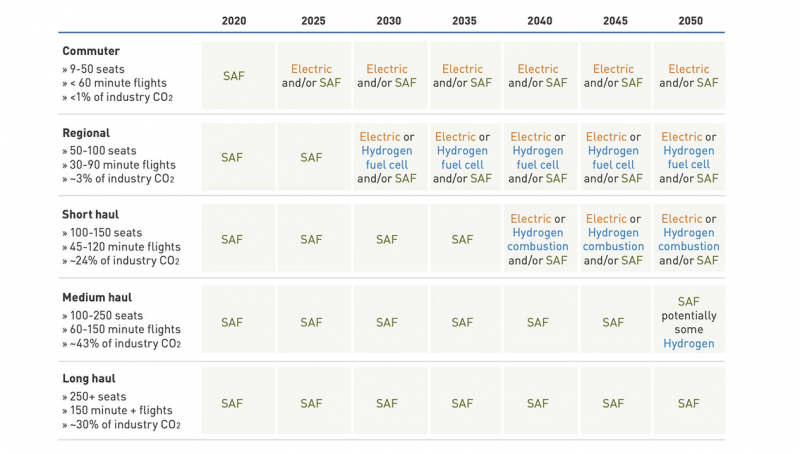Future
The engine of global economy
The last Global Sustainable Aviation Forum was attended by experts from the industry, governments and environmental groups, and was hosted by ATAG and its Executive Director, Michael Gill.
Nov 2020
Since day one, commercial aviation has accounted for the transport of approximately 86.5 billion people around the world: what was a niche sector in the early 1960s boomed and became more widely accessible in the 2000s. Then the 2020 outbreak: according to Skyteam, the global airline alliance, around 5 million people stranded in other countries due to the Covid emergency this year were brought home by air transport.
Data and facts that reported during the recent Global Sustainable Aviation Forum hosted by ATAG (Air Transport Action Group) and which drew to a close on 30 September. Aircraft manufacturers, engine manufacturers, but also airports, airlines, avionics suppliers, pilot and ground and air crew associations, chambers of commerce, tourism and business partners took part to share and jointly commit themselves to the key challenge of the era we’re living in: sustainable aviation for communities and the environment.
GE Aviation is one of the many partners of ATAG, as well as one of its founding members. During the forum, in fact, Arjan Hegeman - VP Advanced Technology at GE Aviation - was among the industry leaders who gave their live contribution at the Forum in terms of visions and solutions for propulsion efficiency.

During these critical times, the entire sector found itself at the forum with the objective of sharing Waypoint 2050: not a destination, but a route to Climate Neutrality consisting of milestones (or key steps) made up of strategic and innovative possibilities for achieving the common result of halving CO2 emissions.
The two-day event involving exchanges and debates was chaired by Michael Gill, the Executive Director of ATAG who kind was enough to agree to share once again the feedback and some of the main insights that emerged from the Forum with readers of about magazine.
At the Forum, we learnt that some regions are moving faster and could even achieve zero emissions by 2050 (or 50% as per the Waypoint report): where and how global frameworks, like ICAO, can help bridge the gap and where regional frameworks can play?
“Our Waypoint 2050 report, released at the Global Sustainable Aviation Forum, outlines a few potential pathways to meet our industry-wide 2050 goal to halve net CO2 emissions below 2005 levels. It shows that although it is a massive challenge, that goal is achievable. What we also show is that net-zero CO2 for aviation could be achieved at a global level by around 2060. Some regions could be in a position to move to that point earlier and there are already some 20 airlines and some regions working on roadmaps to net-zero in 2050. We fully support those initiatives and encourage all parts of the sector to work on this ambition, realizing that some parts of the world may need a little more time to transition.”
"There are a lot of exciting developments in the 'green propulsion' technologies area, hydrogen and electric amongst them, and we urge the OEMs and research institutions to step up development and testing of these solutions"
Looking at the Covid dramatic impact on the global aviation industry, do you see the industry returning back to pre-crisis or just resized levels?
“Covid-19 has hit aviation harder than any previous shock, returning us to traffic levels not seen in 20 years and it will have a profound impact on the jobs and economic benefits aviation can support. We estimate up to 46 million jobs which air transport would normally support are at risk by the end of this year. In terms of emissions, we may actually end the year with a lower CO2 footprint than since the mid-1980s. We know that passengers want to fly, want the experiences and the connectivity that air travel brings, so they will come back. But the stoppage has been so profound that we are expecting a complete reset of air traffic growth all the way out to 2050 – about 16% lower than in the pre-Covid. This is driven by a range of factors: a lower GDP growth and economic situation globally, hesitation for older demographics to travel as much due to health concerns and a long recovery for business travel with companies having got used to video conferencing services.”
Are some airplane types never returning (i.e. narrow vs widebody) and, in case some types of fleets are going to retire, do you see impact on the permanent fleet carbon emissions reduction associated with this retired part of the fleet?
“There will certainly be an impact on fleet fuel efficiency once we are able to get aircraft back in the air again. A number of older generation and less efficient aircraft are exiting the fleet more rapidly than they otherwise would have. However, we are not sure how this may be offset by airlines being less able to invest in new aircraft, particularly in the next few years. Overall our instinct is that we’ll be left with a more modern, fuel-efficient fleet as we start to recover.”
What “green propulsion” technologies most excite you and do you feel are putting us on the best path forward to helping our industry meet our sustainability targets?
“There are a lot of exciting developments in this area – hydrogen and electric amongst them – and we urge the OEMs and research institutions to step up development and testing of these solutions. They will potentially provide a step-change shift towards zero carbon connectivity for short-haul operations. But we also must keep our focus on decarbonising medium- and long-haul and for that we will need a complete energy transition to sustainable aviation fuels. We know they work, we know roughly how much we need thanks to the Waypoint 2050 analysis, we know where we could get them from. Scaling up is now the key challenge and we need to spend the next 10 years ensuring we have the right foundations in place to make that a reality.”
What “green propulsion” technologies most excite you and do you feel are putting us on the best path forward to helping our industry meet our sustainability targets?
“There are a lot of exciting developments in this area – hydrogen and electric amongst them – and we urge the OEMs and research institutions to step up development and testing of these solutions. They will potentially provide a step-change shift towards zero carbon connectivity for short-haul operations. But we also must keep our focus on decarbonising medium- and long-haul and for that we will need a complete energy transition to sustainable aviation fuels. We know they work, we know roughly how much we need thanks to the Waypoint 2050 analysis, we know where we could get them from. Scaling up is now the key challenge and we need to spend the next 10 years ensuring we have the right foundations in place to make that a reality.”
Speaking about SAF and Hydrogen, many concerns generated from costs and also from required technology maturation and timing: what’s your view and eventual solutions?
“SAF and hydrogen have similar challenges, although with SAF the technology is much more mature. SAF also probably has less of a challenge with distribution to airports as it can be dropped-in to existing supply systems. For both, scaling up is going to be key to help increase supply and reduce costs. Governments and the energy industry have the most important role to play, investing in the energy transition, providing the right policy environment and capitalizing on their expertise to make the challenge a reality.”
“Invest, invest, invest! I know saying 'it is a challenging time' somewhat understates what we are all going through, but we need to double-down on research into advanced efficiency technologies – both evolutionary and revolutionary. The sooner we can bring these to market, the better”
Carbon offsets … how would you convey them and how much do you think they will come into play?
“Offsets are a way to help reduce CO2 emissions outside your own sector when technology doesn’t exist or it is too expensive to reduce emissions yourself. At the moment, they help support projects like renewable energy installations in developing nations. Eventually, they will focus on carbon removal opportunities. These can be natural, like restoring high carbon sink natural environments or forests. But there are also technological fixes under development such as direct air capture which literally sucks CO2 out of the atmosphere. We see offsetting taking a couple of roles: in the medium-term we will rely on these measures to help compensate for CO2 emissions as we develop SAF and new technologies which will bring down emissions. In the long-term, we may need offsets to deal with any remaining CO2 emissions that simply can’t be avoided. But the Waypoint 2050 analysis shows we can meet the long-term climate goals of the industry (and also net zero) without offsetting being a central pillar of reduction.”
In your opinion, what role should the governments and institutions play in aviation sustainability?
“Governments need to play a central role in responding to the climate challenge – including in aviation. We need them to help in a range of areas, including: funding advanced research into new technologies and opportunities for sustainable aviation fuels; helping to get SAF off the ground with the right policy and investment environment; and ensuring that our airspace is operating at its most efficient by modernizing air traffic management. Most importantly, by working in collaboration with the industry to make these things all come to fruition.”
Cover illustration by Margherita Fruscoloni Morello






